Super Mistral Sport
Sailboat specifications
The Super Mistral Sport is a 22’7” (6.9m) cruising sailboat designed by Henri Amel (France) and François Sergent (France). She was built between 1961 and 1972 by Amel (France).
Super Mistral Sport's main features
- Model
- Super Mistral Sport
- Hull type
- Monohull
- Category
- Cruising sailboat
- Sailboat builder
- Sailboat designer
- Country
- France
- Construction
- Hull and deck: GRP (glass reinforced polyester)
- Number of hulls built
- About 350
- First built hull
- 1961
- Last built hull
- 1972
- Appendages
- Keel : fin without bulb
- Helm
- Single tiller
- Rudder
- Single spade rudder
- Unsinkable
- No
- Trailerable
- Yes
- Standard public price ex. VAT (indicative only)
- N/A €
Super Mistral Sport's main dimensions
- Overall length
- 23’ 2”7.06 m
- Hull length
- 22’ 7”6.9 m
- Waterline length
- 20’ 6”6.25 m
- Beam (width)
- 7’ 5”2.25 m
- Draft
- 3’ 5”1.04 m
- Light displacement (MLC)
- 2646 lb1200 kg
- Ballast weight
- 1168 lb530 kg
- French customs tonnage
- 3.67 Tx
Super Mistral Sport's rig and sails
- Upwind sail area
- 292 ft²27.1 m²
- Downwind sail area
- 522 ft²48.5 m²
- Mainsail area
- 135 ft²12.5 m²
- Genoa area
- 157 ft²14.6 m²
- Solent area
- 108 ft²10 m²
- Jib area
- 65 ft²6 m²
- Staysail area
- 27 ft²2.5 m²
- Symmetric spinnaker area
- 388 ft²36 m²
- Rigging type
- Sloop Marconi masthead
- Mast configuration
- Deck stepped mast
- Rotating spars
- No
- Number of levels of spreaders
- 1
- Spreaders angle
- 0 °
- Spars construction
- Aluminum spars
- Standing rigging
- 1x19 strand wire
Super Mistral Sport's performances
- Upwind sail area to displacementiThe ratio sail area to displacement is obtained by dividing the sail area by the boat's displaced volume to the power two-thirds.
The ratio sail area to displacement can be used to compare the relative sail plan of different sailboats no matter what their size.
Upwind: under 18 the ratio indicates a cruise oriented sailboat with limited performances especially in light wind, while over 25 it indicates a fast sailboat. - 258 ft²/T24 m²/T
- Downwind sail area to displacementiThe ratio sail area to displacement is obtained by dividing the sail area by the boat's displaced volume to the power two-thirds.
The ratio sail area to displacement can be used to compare the relative sail plan of different sailboats no matter what their size. - 462 ft²/T42.95 m²/T
- Displacement-length ratio (DLR)iThe Displacement Length Ratio (DLR) is a figure that points out the boat's weight compared to its waterline length. The DLR is obtained by dividing the boat's displacement in tons by the cube of one one-hundredth of the waterline length (in feet).
The DLR can be used to compare the relative mass of different sailboats no matter what their length:
a DLR less than 180 is indicative of a really light sailboat (race boat made for planning), while a DLR greater than 300 is indicative of a heavy cruising sailboat. - 139
- Ballast ratioiThe Ballast ratio is an indicator of stability; it is obtained by dividing the boat's displacement by the mass of the ballast. Since the stability depends also of the hull shapes and the position of the center of gravity, only the boats with similar ballast arrangements and hull shapes should be compared.
The higher the ballast ratio is, the greater is the stability. - 44 %
- Critical hull speediAs a ship moves in the water, it creates standing waves that oppose its movement. This effect increases dramatically the resistance when the boat reaches a speed-length ratio (speed-length ratio is the ratio between the speed in knots and the square root of the waterline length in feet) of about 1.2 (corresponding to a Froude Number of 0.35) . This very sharp rise in resistance, between speed-length ratio of 1.2 to 1.5, is insurmountable for heavy sailboats and so becomes an apparent barrier. This leads to the concept of "hull speed".
The hull speed is obtained by multiplying the square root of the waterline length (in feet) by 1.34. - 6.07 knots
Super Mistral Sport's auxiliary engine
- Engine(s)
- 1 outboard engine
- Engine(s) power (min./max.)
- 4 HP / 10 HP
- Fuel type
- Gas
Super Mistral Sport's accommodations and layout
- Cockpit
- Closed aft cockpit
- Cabin(s)
- 1
- Berth(s) (min./max.)
- 2 / 4

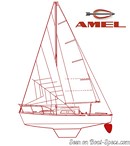

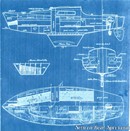
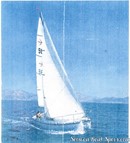
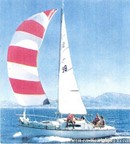
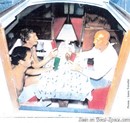

Amel Super Mistral Sport interior and accommodations - - 7/8
Picture extracted from the commercial documentation © Amel
Picture extracted from the commercial documentation © Amel

Similar sailboats that may interest you:
Sailboats
First built hull
Hull length
1985
23’ 7”7.2 m
1965
27’ 1”8.25 m
1966
23’ 4”7.1 m
1995
21’ 6”6.55 m
1985
22’ 7”6.9 m
1962
17’ 2”5.25 m
1982
24’ 7”7.5 m
2005
24’ 6”7.47 m
1976
19’ 8”6 m
1978
19’ 8”6 m
1970
21’ 8”6.6 m
1983
22’ 6”6.85 m
1973
20’ 4”6.2 m
1977
23’ 7”7.2 m
1978
21’ 6”6.55 m